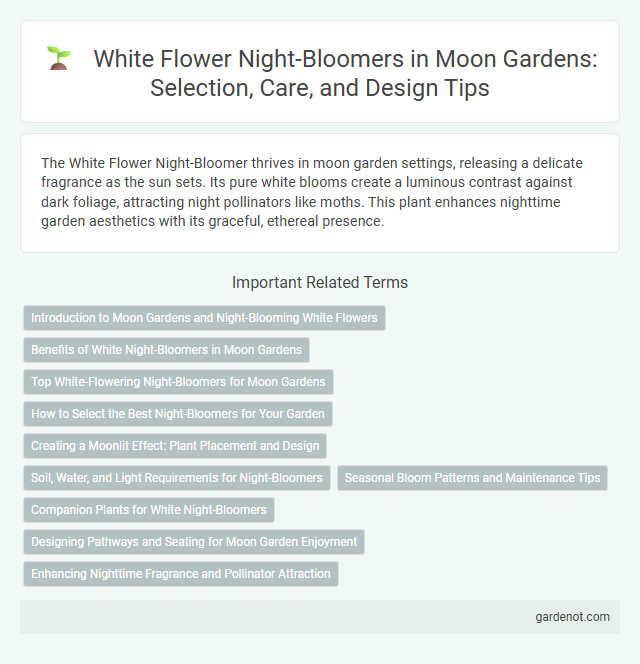The White Flower Night-Bloomer thrives in moon garden settings, releasing a delicate fragrance as the sun sets. Its pure white blooms create a luminous contrast against dark foliage, attracting night pollinators like moths. This plant enhances nighttime garden aesthetics with its graceful, ethereal presence.
Introduction to Moon Gardens and Night-Blooming White Flowers
Moon gardens emphasize plants that reveal their beauty in low light, with white night-blooming flowers acting as focal points due to their luminous petals that reflect moonlight. These flowers, such as the white evening primrose or night-blooming jasmine, emit subtle fragrances that enhance the nocturnal garden experience. Selecting night-blooming white flowers creates a serene, visually striking environment that thrives under moonlight and attracts nocturnal pollinators.
Benefits of White Night-Bloomers in Moon Gardens
White flower night-bloomers in moon gardens enhance nocturnal landscapes by reflecting moonlight, creating a luminous and serene ambiance. Their strong, sweet fragrances attract pollinators such as moths and bats, promoting biodiversity and ecological balance. These plants also support night-active wildlife, improving garden health while providing a unique sensory experience after dusk.
Top White-Flowering Night-Bloomers for Moon Gardens
White flower night-bloomers like the Moonflower (Ipomoea alba) and Night-Blooming Jasmine (Cestrum nocturnum) are essential for moon gardens because their large, fragrant blooms create a luminous focal point after dusk. These plants thrive in warm climates and attract nocturnal pollinators such as moths and bats, enhancing the garden's nighttime biodiversity. Their pale flowers reflect moonlight beautifully, providing a serene and enchanting atmosphere perfect for evening relaxation.
How to Select the Best Night-Bloomers for Your Garden
Choose white flower night-bloomers with strong fragrance and large, vibrant petals to enhance your moon garden's nighttime allure. Opt for varieties like Night-Blooming Jasmine or White Four O'Clocks, which thrive in partial shade and well-drained soil. Prioritize plants with proven night-time blooming patterns and low maintenance needs for a seamless, fragrant evening garden experience.
Creating a Moonlit Effect: Plant Placement and Design
Strategically placing white flower night-bloomers along pathways and near reflective surfaces enhances their luminous appearance, creating a captivating moonlit effect in your garden at night. Their pale petals capture and reflect subtle moonlight, amplifying brightness and adding ethereal charm to dark spaces. Incorporating these night-bloomers with low-growing foliage maximizes visibility and emphasizes their glowing presence under moonlight.
Soil, Water, and Light Requirements for Night-Bloomers
White flower night-bloomers thrive in well-drained, moderately fertile soil that retains moisture without becoming waterlogged. They require consistent watering during the growing season to support their nocturnal blooming cycles, with reduced frequency once established. These plants prefer full moonlight or low ambient light conditions, as direct sunlight during the day may inhibit night-time flower opening.
Seasonal Bloom Patterns and Maintenance Tips
White flower night-bloomers typically bloom from midsummer to early fall, showcasing fragrant blossoms that open after dusk and close by morning. These plants thrive in well-drained soil with consistent moisture, requiring minimal pruning to maintain their shape and encourage healthy growth. Regularly removing spent flowers and monitoring for pests helps ensure a vibrant and enduring night garden display.
Companion Plants for White Night-Bloomers
White flower night-bloomers thrive alongside fragrant companions like jasmine and gardenia, which enhance nighttime pollinator activity. Moonflowers and evening primroses complement their ethereal blooms while attracting moths and bats vital for cross-pollination. Placing night-blooming cereus nearby ensures a visually stunning and ecologically balanced moon garden.
Designing Pathways and Seating for Moon Garden Enjoyment
White flower night-bloomers, such as moonflowers and evening primroses, emit a luminous glow that enhances nighttime garden ambiance. Designing pathways with soft, reflective materials and integrating seating areas close to these blossoms maximizes the sensory experience of their gentle fragrance and radiant blooms. Strategic lighting with low-intensity, warm LEDs complements the natural luminescence, encouraging extended moon garden enjoyment.
Enhancing Nighttime Fragrance and Pollinator Attraction
White flower night-bloomers in a moon garden release intense fragrances after dusk, creating a captivating sensory experience for nighttime visitors. Their aromatic compounds are specifically evolved to attract nocturnal pollinators such as moths and bats, ensuring effective pollination under low-light conditions. Incorporating these plants enhances both the ecological value and the sensory appeal of nighttime garden spaces.
White flower night-bloomer Infographic

 gardenot.com
gardenot.com